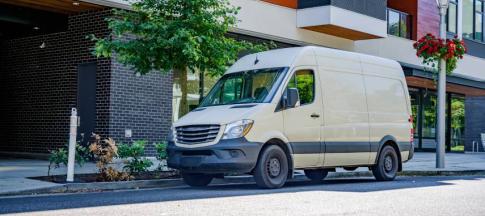
Defining cars and vans is essential for tax and insurance purposes.
However, dual-purpose vehicles like crew vans, Kombi and pick-ups capable of carrying passengers means defining cars and vans is now more difficult.
Below, we answer how to define cars, vans and car-derived vans and how to find out what you’re driving.
The definition of cars and vans
A van (or commercial vehicle) has a primary function: to carry goods. A car, according to HMRC, is a vehicle that isn’t a goods (commercial) vehicle.
So, defining a car or a van comes down to one point: is it a commercial vehicle?
Defining car-like vans
Car-Derived Vans
HMRC defines a car-derived van as “a goods vehicle which is constructed or adapted as a derivative of a passenger vehicle”.
In simple terms, it’s a van you can buy as a car, like the Ford Fiesta or Vauxhall Corsa.
From the outside, they look like a car; inside, the vehicle functions like a van with no rear seats and a large payload area. Typically, they’ll have no side or rear windows.
Double cabs (often called crew, or Kombi vans)
This is the area that causes the most confusion. What if you’ve a van such as a Volkswagen Transporter or a Ford Transit that has a second row of seats?
Specific guidance isn’t easy to find. To consider a van as a commercial vehicle for taxation purposes, it needs to meet some criteria:
- the payload capacity must be a minimum of 1000kgs
- HMRC considers loadspace, meaning if the loadspace is small, and the second row of seats occupies a larger area, there could be an argument that the vehicle's primary purpose is to carry passengers, not goods.
Pick-up trucks (Ford Ranger, Toyota Hilux, Nissan Navara, etc.)
The key thing for a pick-up truck to become a commercial vehicle is if the vehicle’s payload is over 1000kgs.
Most double-cab pick-ups have a carrying capacity over this, but you need to ensure it stays over this figure. A few popular pick-ups have small payloads, like the Ford Ranger Raptor.
Small payload vehicles are passenger-carrying vehicle, so they'd be taxed and insured as a car. Always check the payload, or you might not be able to reclaim VAT on the pick-up purchase.
What happens if my commercial vehicle is a car?
- it could impact your insurance, meaning you’ll have no protection or may not have cover in an accident
- you’ll be unable to reclaim the VAT you have paid on the purchase or as part of a lease agreement (unless you can prove that the vehicle is used 100% for business purposes)
- you’ll lose the Benefit in Kind taxation, meaning you’ll pay a high rate of tax
How to find out if you have a van or a car
Your V5 logbook
The V5C document (known as a registration document or ‘logbook’) offers guidance on whether your vehicle is a car or a van.
A manufacturer must declare the class of the vehicle at the point that it leaves the factory gates. They use four classifications:
- M1 - cars
- M2 – minibus
- N1 and N2 – commercial vehicle
However, this doesn’t account for car modifications after the vehicle leaves the factory. That means your N1 may turn into an M1, meaning it’ll have different insurance and tax implications.
It’s worth remembering that modifying your vehicle could invalidate your insurance.
HMRC and your insurance provider may have a different opinion too. The V5C isn’t perfect, but it can give you a general idea of what you’re driving.
Car, van and LCV specifications
Vehicle specifications can help. For example, a van with just front seats and loadspace in the rear is probably a commercial vehicle. A car with all its seats is a car.
You can weigh your vehicle too.
To get classified as a van, it'll need to have a payload of over 1,000kgs. The chassis plate will give the Gross Vehicle Weight (GVW or GVM), and if you subtract the weight of the empty van from the GVW, you'll have your payload figure.
Governing body guidelines
HMRC offers some assistance with car-derived vans. You can find information on the .GOV website.
The differences between car and van insurance
Van and car insurance are different – each has its level of risk, features and cover, so picking the right one is essential.
Your vehicle needs the correct insurance. For example, you can’t drive a car on your van insurance – it’ll invalidate your cover. If you need to cover both a car and a van, MultiCar insurance will help.
If you’re confused about getting the right policy, contact us.
We also recommend talking to your vehicle dealer, manufacturer and HMRC if you need advice – it’s your responsibility to stay within tax and insurance regulations.
I started my career selling vans in the mid-eighties, progressing through dealer groups to management level. In 2010 I joined vehicle valuation company CAP, being made responsible for forecasting future used values for all makes and models of vans and trucks, this data being used by leasing companies and manufacturers to assess future risk. This role entailed very early exposure to new models including extensive testing across Europe.
In 2016 I started up my own consultancy business dedicated to the LCV industry. In addition, my freelance written work has been used by a number of clients and I am a regular contributor to WhatVan? magazine. I’m also a judge for their annual ‘Van of the Year’ awards.
To relax, I enjoy travel and walking near my Yorkshire home.



